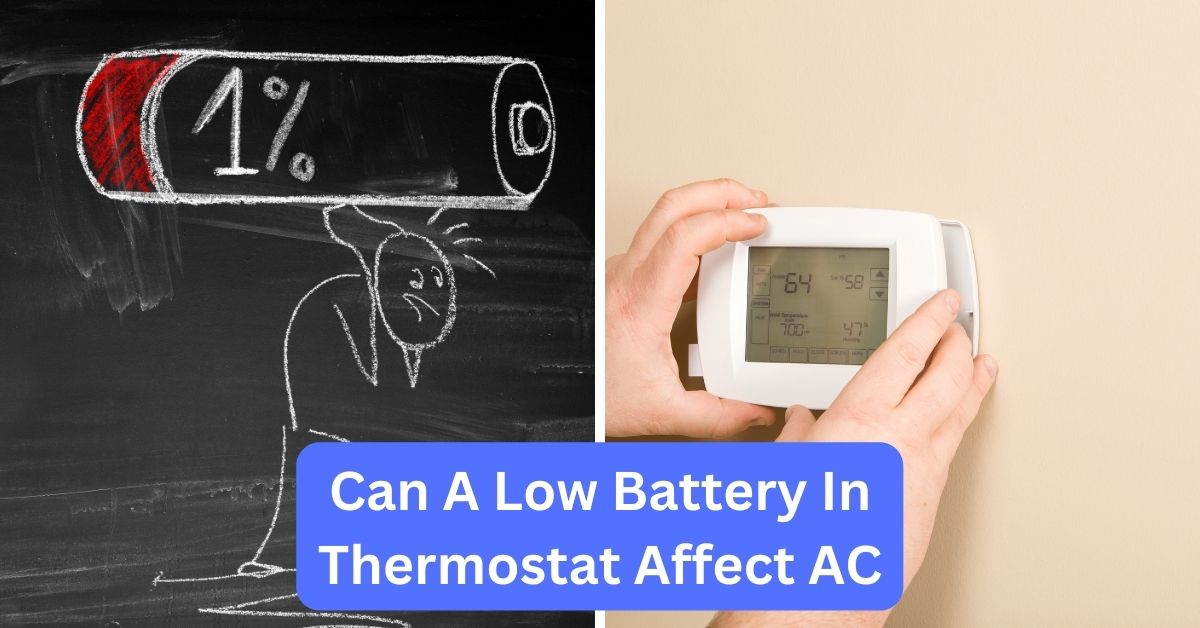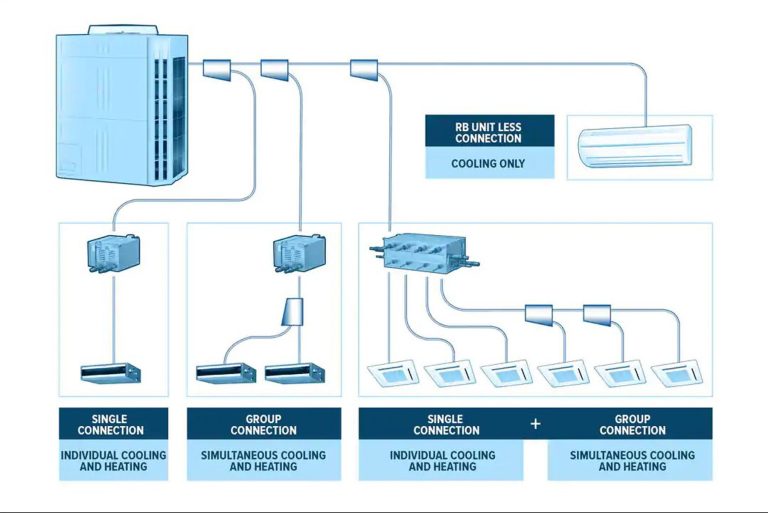Can A Low Thermostat Battery Affect Air Conditioning? Get The Answers Here
Yes, a low battery in a thermostat can affect the air conditioning system. When the thermostat’s battery is low, it may not be able to communicate with the air conditioning system effectively, causing issues with temperature control and overall performance. It is important to regularly check and replace the batteries in the thermostat to ensure proper functioning of the air conditioning.
Have you ever walked into your home on a scorching summer day, expecting a refreshing blast of cool air from your air conditioning system, only to find it barely making a difference? As homeowners and renters, we rely on our thermostats to control the temperature and maintain a comfortable indoor environment. But what if I told you that a simple, overlooked factor, like a low battery in your thermostat, could be the reason behind your inefficient air conditioning system?
In this blog article, we will delve into the puzzling question, “Can a low battery in a thermostat affect air conditioning?” Whether you are a tech-savvy homeowner or a curious renter, understanding the impact of a low battery on your thermostat is crucial for optimizing your air conditioning system’s performance and saving on energy costs.
Throughout this comprehensive guide, we will explore the common problems caused by a low battery in your thermostat and the effects it has on your air conditioning unit. From compromised temperature control to increased energy consumption, we will shed light on the potential consequences of neglecting this seemingly insignificant issue.
But fear not! We will also provide you with practical tips and step-by-step instructions on how to diagnose and resolve a low battery problem in your thermostat. By the end of this article, you will have the knowledge and tools to ensure your thermostat is always in top-notch condition, allowing you to bask in the coolness of your air conditioning system whenever you need it. So, if you’re tired of sweating it out in an inadequately cooled home due to a mysterious culprit, join us on this enlightening journey as we uncover the impact of a low battery in your thermostat on your air conditioning.
Say goodbye to discomfort and skyrocketing energy bills, and take control of your indoor climate. Your cool, comfortable oasis awaits!

Can a Low Battery in Thermostat Affect Air Conditioning?
The Importance of a Fully Functional Thermostat
As homeowners and renters, we rely on our thermostats to control the temperature and maintain a comfortable indoor environment. The thermostat serves as the command center for our air conditioning system, allowing us to adjust the temperature to our liking with a simple flick of a switch or press of a button. It is a crucial component that ensures our homes are cool and inviting, especially during the sweltering summer months.
But what happens when a seemingly insignificant factor, such as a low battery in your thermostat, disrupts the harmony of your air conditioning system? Can something as small as a low battery really affect the performance of your air conditioner? Let’s explore this question in more detail.
The Impact of a Low Battery on Your Thermostat
A low battery in your thermostat can have a significant impact on its functionality and, consequently, on your air conditioning system. When the battery in your thermostat is running low, it may cause various problems that can affect the performance of your air conditioner.
1. Temperature Inaccuracy
One of the most common issues caused by a low battery in your thermostat is temperature inaccuracy. Your thermostat may struggle to accurately measure and maintain the desired temperature in your home, resulting in an uncomfortable indoor environment.
For example, if you set your thermostat to 72 degrees Fahrenheit, but the low battery prevents the thermostat from functioning properly, it may not be able to accurately detect and regulate the temperature. As a result, your air conditioning system may not cool your home to the desired temperature, leaving you feeling hot and frustrated.
2. Unresponsive Controls
Another issue that can arise from a low battery in your thermostat is unresponsive controls. When the battery is running low, your thermostat may become unresponsive to your commands or may have a delayed response time.
Imagine standing in your living room, desperately trying to lower the temperature, but the buttons on your thermostat fail to register your inputs. This frustrating situation can occur when the battery is low and unable to power the thermostat adequately.
3. Increased Energy Consumption
A low battery in your thermostat can also lead to increased energy consumption and higher utility bills. When the battery is running low, your thermostat may struggle to communicate with your air conditioning system effectively. This can result in your air conditioner consuming more energy than necessary, as it tries to compensate for the inaccurate temperature readings and maintain the desired temperature.
The increased energy consumption not only has a negative impact on the environment but also puts a strain on your wallet. Higher utility bills can quickly add up, especially during the peak summer months when your air conditioning system is working overtime to combat the heat.

Diagnosing and Resolving a Low Battery Problem
Now that we understand the potential problems caused by a low battery in your thermostat, let’s explore how you can diagnose and resolve this issue. By following these practical tips and step-by-step instructions, you can ensure that your thermostat is always in top-notch condition, allowing you to enjoy the coolness of your air conditioning system without any disruptions.
1. Check the Battery Indicator
The first step in diagnosing a low battery problem is to check the battery indicator on your thermostat. Many modern thermostats have a battery icon or a low battery indicator that alerts you when the battery is running low. If you see this indicator, it’s time to replace the battery.
2. Replace the Battery
To replace the battery in your thermostat, follow these simple steps: 1. Locate the battery compartment on your thermostat. The location may vary depending on the model, so consult the user manual if necessary. 2. Open the battery compartment and remove the old battery. 3. Insert a new battery of the same type and size, making sure to align the positive and negative ends correctly. 4. Close the battery compartment securely. 5. Wait for a few seconds to allow the thermostat to recognize the new battery. Once you have replaced the battery, your thermostat should regain full functionality, and any issues caused by the low battery should be resolved.
3. Regular Battery Maintenance
To prevent future low battery problems, it’s essential to incorporate regular battery maintenance into your routine. Here are some tips to keep your thermostat battery in optimal condition: – Check the battery level regularly and replace it as needed. – Consider using high-quality, long-lasting batteries to minimize the frequency of replacements. – Clean the battery contacts periodically to ensure a reliable connection between the battery and the thermostat. By following these maintenance tips, you can minimize the chances of experiencing a low battery problem in your thermostat and ensure the smooth operation of your air conditioning system.
In conclusion, a low battery in your thermostat can indeed affect the performance of your air conditioning system. From temperature inaccuracy to unresponsive controls and increased energy consumption, the impact of a low battery on your thermostat can be significant. However, by regularly checking and replacing the battery, you can avoid these issues and ensure that your air conditioning system operates efficiently and effectively.
Don’t let a simple, overlooked factor like a low battery compromise your comfort and increase your energy bills. Take control of your indoor climate by maintaining a fully functional thermostat, and enjoy the cool oasis of your air conditioning system whenever you need it.
So, the next time you find yourself sweating in an inadequately cooled home, remember to check the battery in your thermostat. It may be the key to unlocking the full potential of your air conditioning system and keeping you cool and comfortable all summer long.
Troubleshooting if a Thermostat is BAD: Explained!
Frequently Asked Questions (FAQ)
Can a low battery in the thermostat affect air conditioning?
How can I check if the thermostat battery is low?
What should I do if the thermostat battery is low?
Will a low thermostat battery completely disable the air conditioning?
Can I still use the air conditioning if the thermostat battery is low?
Final Words: Maintaining a Fully Charged Battery for a Fully Functional Air Conditioning System
In conclusion, a low battery in your thermostat can indeed have a significant impact on the functionality of your air conditioning system. It can lead to temperature inaccuracy, unresponsive controls, and increased energy consumption.
However, by regularly checking and replacing the battery, you can avoid these issues and ensure that your air conditioning system operates efficiently. To diagnose and resolve a low battery problem, you can check the battery indicator on your thermostat and replace the battery if necessary.
Make sure to follow the proper steps to replace the battery and consider incorporating regular battery maintenance into your routine. By maintaining a fully functional thermostat, you can avoid the frustration of an uncomfortable indoor environment and higher utility bills. Don’t overlook the importance of a fully charged battery in your thermostat, as it plays a crucial role in keeping your home cool and inviting.
So, the next time you notice temperature fluctuations or unresponsive controls in your air conditioning system, remember to check the battery in your thermostat. Maintaining a fully charged battery will ensure that you can enjoy the cool oasis of your air conditioning system whenever you need it. Take control of your indoor climate and stay cool and comfortable all summer long.






